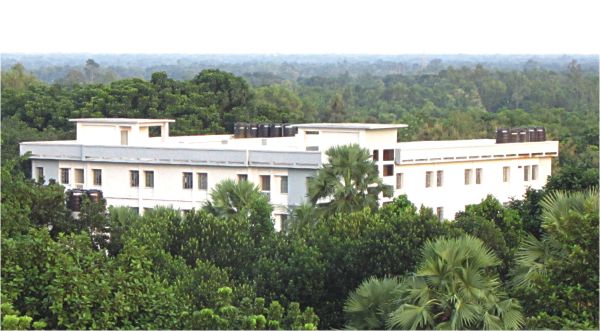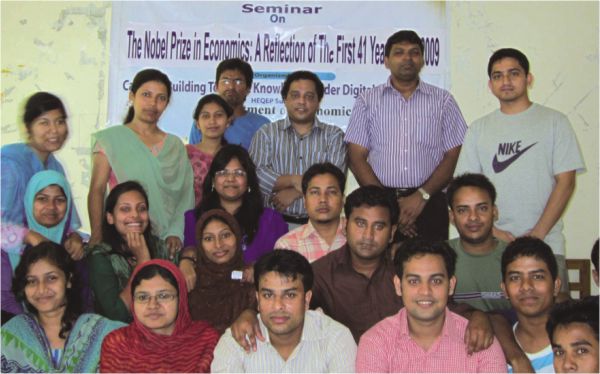Post Campus

Nawab Faizunnesa Chowdhurani Hall, Comilla University. Courtesy
The Nobels in Economics at Comilla University
Asrar Chowdhury
The four walls and roof of the claustrophobic classroom constrain discussing history of ideas that lie outside the boundaries of the normal curriculum in the Economics Departments of Bangladesh. When the Department of Economics at Comilla University asked me to give a talk on the Nobel Prize in Economics, I saw an opportunity that normally does not come. On September 19, 2012, I found myself talking on the Nobel Laureates in Economics with Economics students of Comilla University.
In 1968, to celebrate its 300th Anniversary, the Central Bank of Sweden initiated “The Bank of Sweden Prize in Economic Sciences in Memory of Alfred Nobel” to be awarded in the same spirit as the Nobel Prizes initiated by Alfred Nobel in his will and on the same day, December 10, the death anniversary of Alfred Nobel. The first prize was awarded to Ragnar Frisch and Jan Tinbergen in 1969 for their contributions in the field of Econometrics. Since then, the prize has been awarded each year.
Initial Nobel Prizes in Economics showed a tendency to honour established Economists of the 1960s. These initial Nobel Prizes were divided under four broad categories with one special category. Contributions of the initial Nobel Prize winners are now a standard feature of Economics texts.
Microeconomics, General Equilibrium, and Welfare theory forms the theoretical foundations of mainstream Economics. This branch generates from the neoclassical school in the mid 19th century. It was during this time, Economics slowly started becoming a mathematical science within the social sciences. John Hicks and Kenneth Arrow (1972); Gerard Debreu (1983) and Amartya Sen (1998) received the prize for their contributions. Paul Samuelson (1970) and Maurice Allais (1988) received the Prize under this category, but for their special contributions to the field of Microeconomics. Macroeconomics and Growth Theory has its roots in the Keynesian School of the 1930s. This genre has attracted the highest number of Nobel Prizes because at the beginning of the 1970s, research in this field was the most advanced. Simon Kuznets (1971); Gunnar Myrdal and Friedrich Hayek (1974); Milton Freidman (1976); Franco Modigiani (1985); Robert Solow (1987); Robert Lucas (1995) are some of the Economists who won Nobels under this genre.

With students and the Chair of Economics, Comilla University. Courtesy
International Trade Theory developed as a branch within Microeconomics and Macroeconomics. Bertil Ohlin and James Meade (1977); and Paul Krugman (2008) are the popular Economists under this genre. Econometrics is an applied branch of probability and statistics that is now an established branch in Economics. Ragnar Frisch and Jan Tinbergen (1969); Lawrence Klein (1980); and Robert Engle and Clive Granger (2003) are some of the Economists whose works have now found places in Economics textbooks. Two Nobel Prizes were awarded under a special category, New Methods of Research to Wassily Leontief (1973) and Richard Stone (1984), for developing the input-output method and national income accounting respectively that have found widespread applications in Economic analysis.
The beauty of Economics has been in its flexibility to attract minds and tools from diversified fields. The moral philosopher, Adam Smith and the stock exchange broker, David Ricardo laid the foundations from where Karl Marx and the Neoclassicists took Economics in two different directions by the middle of the 19th century, but having the same objective- to explain and interpret decisions made by societies and individuals. The 1950s is another watershed in the journey of Economics. Research during this decade had two important impacts. First, new fields from outside Economics emerged and found places within mainstream Economics. Second, existing fields within the mainstream slowly emerged as separate branches in their own right. In recent times, the Nobel Prize in Economics is acknowledging these new fields and branches of the Economics Discipline.
Nobel Prizes to W Arthur Lewis and Theodore Schultz (1979) in Development Economics; George Stigler (1982) in Industrial Organization; James Buchanan (1986) in Public Finance and Public Choice; Gary Becker (1992) in Economic Sociology; Robert Fogel and Douglass North (1993) in Economic History; Daniel Kahneman and Vernon Smith (2002) in Experimental and Behavioural Economics; and Lenid Hurwicz, Eric Maskin and Roger Myerson (2007) in Mechanism Design Theory acknowledge some of the new fields that have broadened the scope of the Economics Discipline. Two Nobels to Financial Economics (1990 and 1997); Institutional Economics (1991 and 2009); Game Theory (1994 and 2005) and Economics of Information (1996 and 2001) clearly show how far Economics has come since its formal inception through Adam Smith's Wealth of Nations in 1776. New fields are surfacing. It will not be too long that Feminist Economics, Ethics and Economics, Neuronomics, and Evolutionary Economics find themselves in the Nobel Club of Economics.
As long as a discipline remains open to change, it will evolve and proceed forward. What is now at the frontier, will soon find itself in texts of the Curricula of Departments of Economics, be that in Comilla University where this talk was given or anywhere else in the world. The Nobel Prize in Economics reflects the beauty of Economics- its resilience to proceed forward.
(The author teaches economic theory at Jahangirnagar University and North South University.)
| 